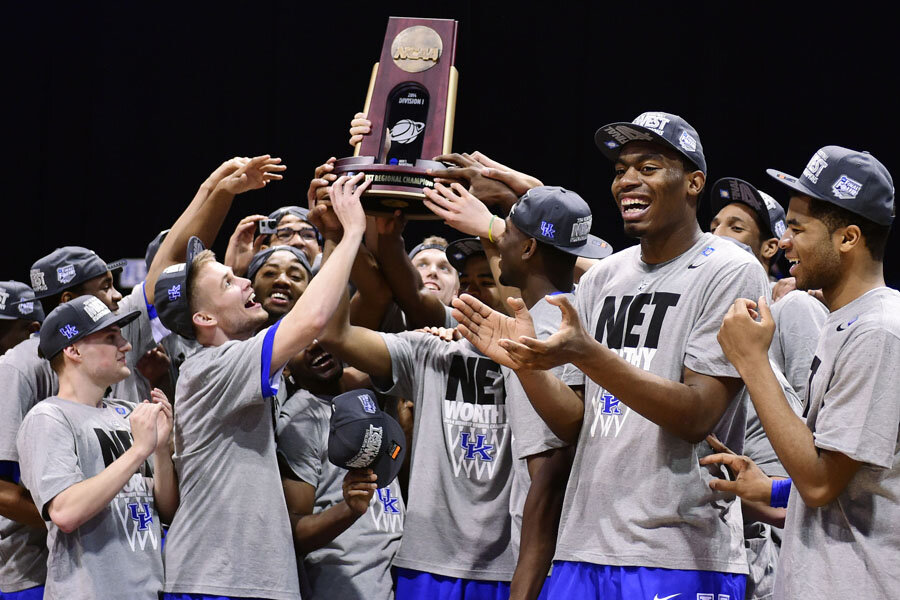After wild weekend, NCAA 'Final Four' teams set for national championship push
Loading...
| Boston
Broadcast ratings suggest this has been the most-watched NCAA tournament in over two decades, and the reasons for that are several and significant. In addition to six nail-biting tournament overtime sessions, two lower-seeded - arguably underseeded - teams, #8 Kentucky and #7 Connecticut, proved themselves truly “elite” Sunday with respective wins in the NCAA tournament Midwest and East regional finals.
These riveting contests came in the wake of Saturday’s convincing "Elite Eight" win by the South Region’s champion Florida over the Cinderella Dayton Flyers, 62-52, and Wisconsin’s thrilling overtime victory in the West over Arizona, 64-63.
Kentucky was a marvel all by itself. Their starters composed entirely of freshmen, the Wildcats played like savvy veterans in defeating the offensive powerhouse Michigan Wolverines, 75-72, at Indianapolis’s Lucas Oil Stadium. The final shot, a nearly 25-foot three by point guard Aaron Harrison, hit nothing but net and devastated the Wolverines (28-9) and guard Nik Stauskas, who hit for 24 points, including 10-11 from the free throw line in addition to eight field goals.
But perhaps the most remarkable contribution came from Kentucky reserve forward Marcus Lee, who scored ten critical points. He hadn’t played since the 2nd week of January, and never missed a shot in scoring his ten points inside of ten minutes. He was playing in place of Willie Cauley-Stein, who was injured in their last game against Louisville and who did not suit up. The Wildcats (28-10) also out-rebounded Michigan, 35-24. During the game's waning minutes, UK players were repeatedly grabbing boards against the smaller Wolverines, which helped provide the winning margin.
In the game preceding that one, the Michigan State Spartans stalled from the very beginning of their contest against the University of Connecticut in New York City’s Madison Square Garden―a virtual sea of navy UConn jerseys in the stands―and never managed to gain their composure in falling to the Huskies, 60-54. UConn, who’ve won a remarkable 60 times in the Garden, was poised from the beginning and got 25 big points from their senior guard, Shabazz Napier, with forward DeAndre Daniels and fellow-backcourt anchor Ryan Boatwright scoring 12 and 11 points, respectively.
Michigan State (29-9) also turned the ball over 16 times, critical for UConn’s transition game, earning the Huskies an early 12-2 lead, which the Spartans never really recovered from. Michigan State coach Tom Izzo remarked that his players seemed to be mired in “quicksand” and that he had never really seen them spin their wheels like this in a game before. It speaks very highly of a home-court advantage for UConn, for whom the Metro-North system supplied a special, extra New Haven line specifically for the game that would take even more fans to the Garden.
At Memphis’ FedEx Forum Saturday evening, Florida (36-2) got 23 points from its outstanding point guard, Scottie Wilbekin, supplemented, respectively, by Patric Young’s 12 points and Michael Frazier II’s 10. Out-rebounding the smaller Flyers, 37-26, the Gators also got to the foul line 28 times versus Dayton’s 8―each team hitting 75% from the charity stripe. Dayton’s coach Archie Miller, interviewed afterward said his team should be proud of each other. “This group is special, they’ve captured a lot of hearts out there, they rejuvenated a fan base like you can’t imagine … and the objective is to regroup, develop and get back here.”
Later Saturday night, the Wisconsin Badgers fought down the stretch to hang with the Arizona Wildcats (33-5) and their star, junior guard Nick Johnson, en route to a 64-63 overtime victory at Anaheim’s Honda Center - the tournament’s sixth overtime decision. It is the first Final Four appearance for the Badgers’ head coach Bo Ryan, which was largely made possible by the tremendous 28-point offensive effort by Wisconsin’s center, Frank Kaminsky, who notched six of those in the extra frame. For Kaminsky, it’s vindication, of a fashion. The Badgers (30-7), who started out 16-0 against Big Ten competition, lost five of their next six games. But as with Wisconsin generally, Kaminsky has re-surged at the right time.
The Wildcats’ Johnson tallied 16 points, supplemented by teammate Aaron Gordon’s 18 rebounds in what was truly a brutally physical game throughout. But for the Badgers’ Ryan and his team, the overtime battle was sweet in more than one way. Ryan said afterward, this win was on what would have been his father’s 90th birthday. “I just thought I’d throw that in,” he added. And for Wisconsin’s players, they had a surprise visit afterward in the locker room by Super Bowl-winning Green Bay Packers quarterback Aaron Rodgers, who said he’d been following them the entire year.





